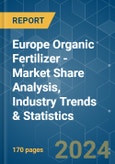The Europe Organic Fertilizer Market size is estimated at USD 4.20 billion in 2024, and is expected to reach USD 6.14 billion by 2029, growing at a CAGR of 7.89% during the forecast period (2024-2029).
Key Highlights
- Meal Based Fertilizers is the Largest Form : Meal-based fertilizers are by-products of the meat processing industry that are increasingly being used in Europe, are rich in nitrogen, phosphorus, potassium, and calcium.
- Manure is the Fastest-growing Form : Manure is an inexpensive organic fertilizer, provides nutrients for soil life, increases biological activity, and diversity and rich in nitrogen, phosphorus, and potassium.
- Row Crops is the Largest Crop Type : The major row crops produce include Barley, corn, wheat, rapeseed, rye, sunflower, soybean, rice, etc. Meal Based Fertilizers most consumed in row crops with 62.3% in 2022.
- France is the Largest Country : France is the largest market in the European Region for organic fertilizers. Manure is the most consumed organic fertilizers in the country, accounting for 74.1% in 2022.
Europe Organic Fertilizer Market Trends
Meal Based Fertilizers is the largest Form
- The European organic fertilizers market in 2022 was primarily dominated by meal-based fertilizers, which accounted for 62.0% of the market. These fertilizers are highly beneficial to agricultural crops as they are rich in nitrogen, phosphorus, potassium, and calcium. Organic fertilizers based on meat and bone meal help reduce the demand for mineral fertilizers and provide an eco-friendly solution for disposing of large amounts of meat processing waste. Manures also contributed significantly to the European organic fertilizers market, registering a share of 38.3% in 2022. The segment's market value recorded an increase of 58.2% between 2017 and 2022.
- Row crops accounted for a significant portion of the organic fertilizer consumption in 2022 in Europe, with a share of 77.7%, followed by horticultural crops. This can be attributed to the large cultivation area of row crops in the region, which amounted to 82.3% of the total organic crop cultivation area in 2022.
- The development of a low-carbon economy is a primary goal of the EU's growth strategy, and organic fertilizers have the potential to make a significant contribution to this effort. Organic fertilizers help transfer atmospheric carbon dioxide into the soil, which prevents it from being released back into the atmosphere due to their high organic matter content. This approach is expected to drive the European organic fertilizers market, which is estimated to register a CAGR of 7.8% during the forecast period.
- The European organic fertilizer market in 2022 was dominated by meal-based fertilizers and manures, with row crops being the primary consumers. As the European Union continues to push for a low-carbon economy, the demand for organic fertilizers is expected to increase, driving growth in the market.
France is the largest Country
- Europe has emerged as one of the major producers of organic crops, with 420,000 organic producers as of 2020. In 2022, Europe accounted for 41.7% of the global organic fertilizer market, a testament to the region's dominance in this field. The region's primary crops include wheat, maize, rye, barley, sugar beet, and potatoes, with row crops accounting for the majority of organic fertilizer consumption.
- Europe's organic agricultural acreage has been increasing steadily, with a growth rate of 7.1% from 4.9 million hectares in 2017 to 6.9 million hectares in 2022. This is largely due to the European Commission's objective of increasing the share of organic agriculture to a minimum of 25.0% of the EU's agricultural land by 2030.
- The European Union (EU) is currently revising its fertilizer Regulation for the first time since 2003, aiming to make it easier for new fertilizing products, particularly those containing nutrients or organic matter recycled from biowaste or other secondary raw materials, to enter the market. The new regulation will also establish safety and quality standards for fertilizing products sold in all EU countries. Organic-based fertilizers, with their circular and resource-efficient nature, are precisely the type of fertilizing products targeted by the new regulation.
- Europe's significant presence in the global organic fertilizers market, combined with the region's commitment to increasing the share of organic agriculture, presents a promising future for the organic fertilizers market in Europe. With the upcoming revision of the Fertilizer Regulation, the industry is expected to witness a surge in innovation and growth, providing opportunities for various stakeholders to expand their businesses.
Europe Organic Fertilizer Industry Overview
The Europe Organic Fertilizer Market is fragmented, with the top five companies occupying 1.36%. The major players in this market are Agribios Italiana s.r.l., Coromandel International Ltd., HELLO NATURE ITALIA srl, ORGANAZOTO FERTILIZZANTI SPA and Suståne Natural Fertilizer Inc. (sorted alphabetically).Additional Benefits:
- The market estimate (ME) sheet in Excel format
- 3 months of analyst support
Table of Contents
1 EXECUTIVE SUMMARY & KEY FINDINGS2 REPORT OFFERS7 KEY STRATEGIC QUESTIONS FOR AGRICULTURAL BIOLOGICALS CEOS
3 INTRODUCTION
4 KEY INDUSTRY TRENDS
5 MARKET SEGMENTATION
6 COMPETITIVE LANDSCAPE
8 APPENDIX
Companies Mentioned (Partial List)
A selection of companies mentioned in this report includes, but is not limited to:
- Agribios Italiana s.r.l.
- Angibaud
- APC AGRO
- Coromandel International Ltd.
- Fertikal NV
- HELLO NATURE ITALIA srl
- Indogulf BioAg LLC (Biotech Division of Indogulf Company)
- ORGANAZOTO FERTILIZZANTI SPA
- Plantin
- Suståne Natural Fertilizer Inc.
Methodology

LOADING...










